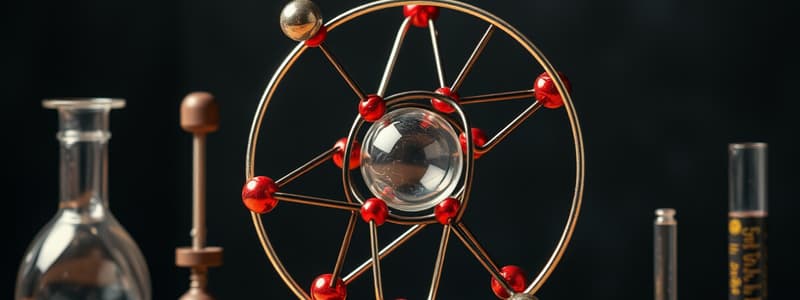Podcast
Questions and Answers
What is the primary purpose of Rutherford's gold foil experiment?
What is the primary purpose of Rutherford's gold foil experiment?
To investigate the structure of the atom and the presence of a nucleus.
Which of the following forces must balance for a stable orbit in Bohr's model of the hydrogen atom?
Which of the following forces must balance for a stable orbit in Bohr's model of the hydrogen atom?
- Outward force (correct)
- Nuclear force
- Electrostatic force (correct)
- Gravitational force (correct)
What does the variable 'n' represent in Bohr's equations?
What does the variable 'n' represent in Bohr's equations?
The principal quantum number.
The total energy of an electron in a Bohr orbit is the sum of its kinetic energy (KE) and its ________ energy (PE).
The total energy of an electron in a Bohr orbit is the sum of its kinetic energy (KE) and its ________ energy (PE).
What is the formula used to calculate angular momentum according to Bohr's model?
What is the formula used to calculate angular momentum according to Bohr's model?
What is the Bohr radius for n = 1?
What is the Bohr radius for n = 1?
What does the electromagnetic absorption spectrum of hydrogen represent?
What does the electromagnetic absorption spectrum of hydrogen represent?
Flashcards are hidden until you start studying
Study Notes
Rutherford’s Gold Foil Experiment
- Most alpha particles passed through gold foil with minimal deflection.
- A few particles were deflected at wide angles, indicating a concentrated positive charge in the atom.
- Occasionally, particles rebounded, detected by a screen or counter positioned behind the foil.
Bohr Theory of the Hydrogen Atom
- Bohr's model features a single electron of mass (me) orbiting a nucleus of mass (mn) at a distance (r).
- For stable orbits, the outward force from the electron's movement balances the attractive forces from the nucleus.
- The significant forces include:
- Electrostatic force (dominant)
- Gravitational force (negligible compared to electrostatic force)
Electrostatic Force
- The electrostatic attractive force (Fe) occurs between an electron (charge -e) and a proton (charge +e).
Total Energy Calculation
- Total energy (E) in a Bohr orbit is the sum of kinetic energy (KE) and potential energy (PE).
- KE is associated with the electron's motion, while PE relates to electrostatic attraction.
- The equilibrium condition for stable orbits is defined by the relationship F0 + Fe = 0.
Angular Momentum and Stability
- Bohr proposed specific quantized values for angular momentum to prevent electrons from falling into the nucleus.
- Allowed angular momentum values follow the formula: L = nh/2π, where n is an integer (1, 2, 3...).
Bohr Radius and Energy Levels
- The radius of electron orbits in a hydrogen atom correlates with the quantum number (n).
- The energy of each orbit can be determined by substituting the orbit radius into the energy formula.
- The first Bohr orbit radius (a0) is calculated when n = 1, resulting in a0 ≈ 0.529177 × 10^-8 cm.
Velocity Calculation
- The velocity of an electron in the first Bohr orbit can be found using the established formula for the specified radius.
Emission and Absorption Spectra of Hydrogen Atoms
- An experimental arrangement is critical for studying hydrogen's emission spectra.
- The absorption spectrum features lines corresponding to ultraviolet radiation that hydrogen absorbs when subjected to a mix of all wavelengths.
Studying That Suits You
Use AI to generate personalized quizzes and flashcards to suit your learning preferences.



